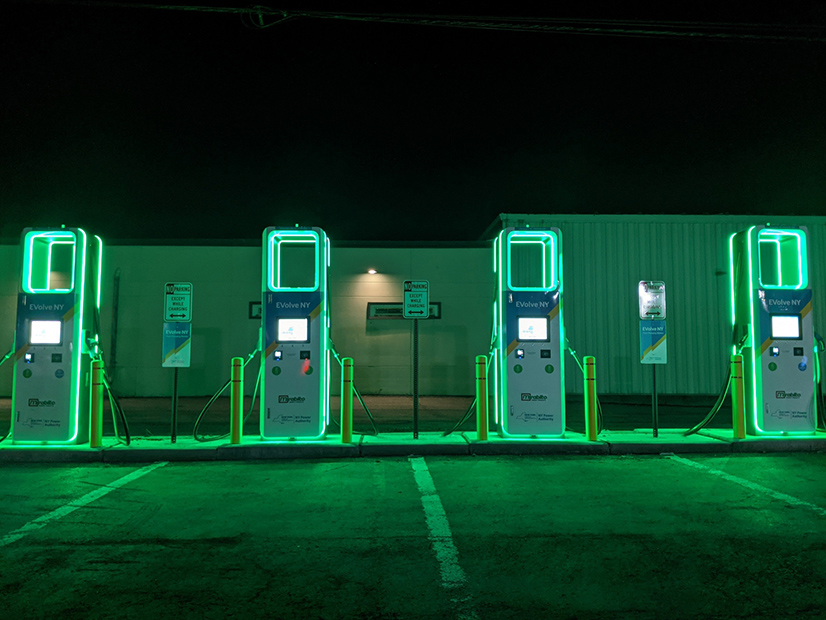
New York utilities say rising costs are hampering their efforts to expand electric vehicle charging infrastructure through the EV Make-Ready Program.
The remarks came Tuesday at the start of a midpoint review held by the state Public Service Commission to assess progress on the five-year, $701 million effort by the state’s large investor-owned utilities.
The Make-Ready Program does not cover the chargers themselves but helps pay for most of the associated costs: up to 50% of costs at private-access or proprietary chargers, 90% at public non-proprietary chargers and 100% of costs in disadvantaged communities.
But it calculates the incentive from a baseline price tag that utilities say is obsolete.
Most of the utility representatives speaking Tuesday said escalating costs have deterred some potential customers from committing to installation of charging stations.
The Joint Utilities of New York (JU) — made up of the six IOUs in the state — said the actual cost of a Level 2 charger ranges from 5% below the baseline price on which the incentives are based for Rochester Gas and Electric (NYSE:AGR), to 39% higher for Consolidated Edison (NYSE:ED). The weighted average statewide is 29% higher.
“The high costs have certainly been a challenge and have led to attrition given that the incentives are limited,” said Cliff Baratta of Con Ed.
Nonetheless, response has been strong, and Con Ed’s Make-Ready pipeline is nearly full, Baratta said. The utility continues to take applications because it knows some applicants will not follow through and commit to installation.
Rising prices are not just affecting EV chargers; EVs themselves have gotten more expensive and are in short supply.
Zeryai Hagos, deputy director of the Office of Markets and Innovation at the Department of Public Service, said the number of EVs and plug-in hybrids registered in New York has roughly doubled to 115,000 since the Make-Ready Program began in New York in 2020, but manufacturers’ production constraints place a ceiling on sales.
“The primary objective of the EV Make-Ready Program is to incentivize the development of enough public EV charging stations to support our zero-emissions vehicle goals and to assuage range anxiety of potential electrical vehicle buyers,” Hagos said.
Worries about being stranded with a depleted battery is one factor that limits EV sales. The purchase cost is another. Sales of new EVs are increasing sharply, but they still account for only a tiny fraction of vehicles on U.S. roads.
“Our customers are not quite seeing the demand from drivers yet to justify the expense of installing EV charging stations without a little bit more financial support on the EV stations themselves,” said Kate Carleo of National Grid. “That said, we do expect interest to stay strong and to be able to ramp up from here.”
She also said the utility has seen several successes so far: deployment of electric public transit buses and heavy trucks, installation of charging stations at auto dealerships, municipal public charging, and assistance provided to school districts with EPA’s Clean School Bus program.
Multiple speakers said the expiration of the New York State Energy Research and Development Authority’s Charge Ready NY incentive a year ago was a significant setback, causing potential customers to postpone or cancel plans to install chargers.
“As a whole, the JU has observed that for many customers, the existing utility incentives and the eligibility structures are not enough to justify a business case to put in chargers,” ICF’s Lauren Kastner said.
“Additionally, most of the JU companies observed a dropoff in applications when the NYSERDA Charge Ready NY funds went away in the fall of 2021. And that meant that many customers proved to be sensitive to the lack of stackable incentives to cover total project costs.”
Kastner suggested raising the baseline costs used to calculate incentives to reflect the actual present-day cost of chargers, as well as additional incentive funding streams.
Adam Ruder of NYSERDA said a successor to Charge Ready NY is in the works: “We are developing a new Level 2 charging program that we are refining and hope to be able to bring out in the not-too-distant future.”
April 2022 status reports by the utilities showed a slow start to the rollout, and Tuesday’s update painted a similar picture.
The goal of the EV Make-Ready Program is 1,500 HVDC fast chargers and 53,733 Level 2 chargers installed by 2025.
So far, 205 DC fast chargers have been installed, with commitments for 298 more and applications submitted for 1,639 others. Meanwhile, 3,344 Level 2 chargers have been installed, with commitments for 8,515 more and applications for 11,099 others.
The midpoint review that commenced Tuesday will continue through early 2023 with stakeholder input, technical conferences and DPS staff recommendations. The revised Make-Ready order is targeted for issuance in mid-2023.



